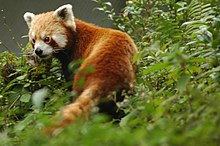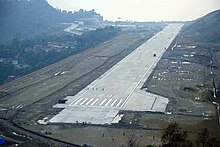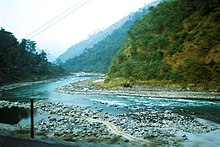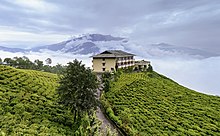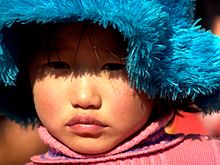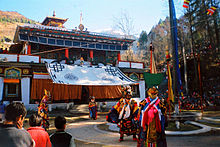Sikkim
|
Sikkim
|
|
|---|---|
| Motto(s):
Kham sum wangdu
(Conqueror of the three worlds) |
|
 |
|
| Coordinates (Gangtok): 27.33°N 88.62°ECoordinates: 27.33°N 88.62°E | |
| Country | |
| Admission to Union † | 16 May 1975 |
| Capital | Gangtok |
| Largest city | Gangtok |
| Districts | 4 |
| Government | |
| • Governor | Ganga Prasad |
| • Chief Minister | Prem Singh Tamang (SKM) |
| • Legislature | Unicameral (32 seats) |
| • Parliamentary constituency | Rajya Sabha 1 Lok Sabha 1 |
| • High Court | Sikkim High Court |
| Area | |
| • Total | 7,096 km2 (2,740 sq mi) |
| Area rank | 28th |
| Population
(2011)[1]
|
|
| • Total | 610,577 |
| • Rank | 29th |
| • Density | 86/km2 (220/sq mi) |
| Demonym(s) | Sikkimese |
| Languages[2][3] | |
| • Official | |
| • Additional official | |
| Time zone | UTC+05:30 (IST) |
| ISO 3166 code | IN-SK |
| HDI | |
| HDI rank | 10th (2017) |
| Literacy | 82.6% (13th) |
| Website | www.sikkim.gov.in |
| † Assembly of Sikkim abolished monarchy and resolved to be a constituent unit of India. A referendum was held on these issues and majority of the voters voted yes. On 15 May 1975 the President of India ratified a constitutional amendment that made Sikkim the 22nd state of India. | |
| Symbols | |
| Emblem | |
| Mammal | |
| Bird | |
| Flower |
Noble dendrobium (Dendrobium nobile)[5][6] |
| Tree | |
Sikkim (/ˈsɪkɪm/) is a state in northeastern India. It borders Tibet in the north and northeast, Bhutan in the east, Nepal in the west, and West Bengal in the south. Sikkim is also located close to India’s Siliguri Corridor near Bangladesh. Sikkim is the least populous and second smallest among the Indian states. A part of the Eastern Himalaya, Sikkim is notable for its biodiversity, including alpine and subtropical climates, as well as being a host to Kangchenjunga, the highest peak in India and third highest on Earth. Sikkim’s capital and largest city is Gangtok. Almost 35% of the state is covered by the Khangchendzonga National Park.[7]
The Kingdom of Sikkim was founded by the Namgyal dynasty in the 17th century. It was ruled by a Buddhist priest-king known as the Chogyal. It became a princely state of British India in 1890. After 1947, Sikkim continued its protectorate status with the Republic of India. It enjoyed the highest literacy rate and per capita income among Himalayan states. In 1973, anti-royalist riots took place in front of the Chogyal’s palace. In 1975, the monarchy was deposed by the people. A referendum in 1975 led to Sikkim joining India as its 22nd state.[8]
Modern Sikkim is a multiethnic and multilingual Indian state. The official languages of the state are English, Nepali, Sikkimese and Lepcha.[2] Additional official languages include Gurung, Limbu, Magar, Mukhia, Newari, Rai, Sherpa and Tamang for the purpose of preservation of culture and tradition in the state.[3] English is taught in schools and used in government documents. The predominant religions are Hinduism and Vajrayana Buddhism. Sikkim’s economy is largely dependent on agriculture and tourism, and as of 2014 the state had the third-smallest GDP among Indian states,[9] although it is also among the fastest-growing.[9][10]
Sikkim accounts for the largest share of cardamom production in India, and is the world’s second largest producer of the spice after Guatemala. Sikkim achieved its ambition to convert its agriculture to fully organic over the interval 2003 to 2016, the first state in India to achieve this distinction.[11][12][13][14] It is also among India’s most environmentally conscious states, having banned plastic water bottles “in any government functions and meetings” and polystyrene products (throughout the state).[15][16]
Contents
Toponymy[edit]
The origin theory of the name Sikkim is that it is a combination of two Limbu words: su, which means “new”, and khyim, which means “palace” or “house”.[17] The Tibetan name for Sikkim is Drenjong (Wylie-transliteration: ‘bras ljongs), which means “valley of rice“,[18] while the Bhutias call it Beyul Demazong, which means ‘”the hidden valley of rice”.[19] According to folklore, after establishing Rabdentse as his new capital, Bhutia king Tensung Namgyal built a palace and asked his Limbu Queen to name it. The Lepcha people, the original inhabitants of Sikkim, called it Nye-mae-el, meaning “paradise”.[19] In historical Indian literature, Sikkim is known as Indrakil, the garden of the war god Indra.[20]
History[edit]
The Lepchas are considered to be the earliest inhabitants of Sikkim.[21] However the Limbus and the Magars also lived in the inaccessible parts of West and South districts as early as the Lepchas perhaps lived in the East and North districts.[22] The Buddhist saint Padmasambhava, also known as Guru Rinpoche, is said to have passed through the land in the 8th century.[23] The Guru is reported to have blessed the land, introduced Buddhism, and foretold the era of monarchy that would arrive in Sikkim centuries later.
Foundation of the monarchy[edit]
Guru Rinpoche, patron saint of Sikkim
According to legend, Khye Bumsa, a 14th-century prince from the Minyak House in Kham in eastern Tibet, received a divine revelation instructing him to travel south to seek his fortunes. A fifth-generation descendant of Khye Bumsa, Phuntsog Namgyal, became the founder of Sikkim’s monarchy in 1642, when he was consecrated as the first Chogyal, or priest-king, of Sikkim by the three venerated lamas at Yuksom.[24] Phuntsog Namgyal was succeeded in 1670 by his son, Tensung Namgyal, who moved the capital from Yuksom to Rabdentse (near modern Pelling). In 1700, Sikkim was invaded by the Bhutanese with the help of the half-sister of the Chogyal, who had been denied the throne. The Bhutanese were driven away by the Tibetans, who restored the throne to the Chogyal ten years later. Between 1717 and 1733, the kingdom faced many raids by the Nepalese in the west and Bhutanese in the east, culminating with the destruction of the capital Rabdentse by the Nepalese.[25] In 1791, China sent troops to support Sikkim and defend Tibet against the Gorkha Kingdom. Following the subsequent defeat of Gorkha, the Chinese Qing dynasty established control over Sikkim.[26]
During the British Raj[edit]
-
Chogyal Tashi Namgyal was credited as a reformer.
-
An 1876 map of Sikkim, depicting Chomto Dong Lake in northern Sikkim.[27] However, the whole of Chumbi and Darjeeling are not depicted as part of Sikkim in the map.
Following the beginning of British rule in neighbouring India, Sikkim allied with Britain against their common adversary, Nepal. The Nepalese attacked Sikkim, overrunning most of the region including the Terai. This prompted the British East India Company to attack Nepal, resulting in the Gurkha War of 1814.[28] Treaties signed between Sikkim and Nepal resulted in the return of the territory annexed by the Nepalese in 1817. However, ties between Sikkim and the British weakened when the latter began taxation of the Morang region. In 1849, two British physicians, Sir Joseph Dalton Hooker and Dr. Archibald Campbell, the latter being in charge of relations between the British and Sikkimese governments, ventured into the mountains of Sikkim unannounced and unauthorised.[29] The doctors were detained by the Sikkimese government, leading to a punitive British expedition against the kingdom, after which the Darjeeling district and Morang were annexed to British India in 1853. The invasion led to the Chogyal of Sikkim becoming a titular ruler under the directive of the British governor.[30]
Sikkim became a British protectorate in the later decades of the 19th century, formalised by a convention signed with China in 1890.[31][32][33] Sikkim was gradually granted more sovereignty over the next three decades,[34] and became a member of the Chamber of Princes, the assembly representing the rulers of the Indian princely states, in 1922.[33]
Indian protectorate and statehood[edit]
-
Flag of Sikkim during its independent monarchy.
-
The last Chogyal, Palden Thondup Namgyal, and his American born queen consort, Hope Cooke, with their daughter in 1971.
Prior to Indian independence, Jawaharlal Nehru, as the Vice President of the Executive Council, pushed through a resolution in the Indian Constituent Assembly to the effect that Sikkim and Bhutan, as Himalayan states, were not ‘Indian states’ and their future should be negotiated separately.[35] A standstill agreement was signed in February 1948.[36]
Meanwhile, Indian independence and its move to democracy spurred a fledgling political movement in Sikkim, giving rise to the formation of Sikkim State Congress (SSC). The party sent a plate of demands to the palace, including a demand for accession to India. The palace attempted to defuse the movement by appointing three secretaries from the SSC to the government and sponsoring a counter-movement in the name of Sikkim National Party, which opposed accession to India.[37]
The demand for responsible government continued and the SSC launched a civil disobedience movement. The Chogyal Palden Thondup Namgyal asked India for help in quelling the movement, which was offered in the form of a small military police force and an Indian Dewan. In 1950, a treaty was agreed between India and Sikkim which gave Sikkim the status of an Indian protectorate. Sikkim came under the suzerainty of India, which controlled its external affairs, defence, diplomacy and communications.[38] In other respects, Sikkim retained administrative autonomy.[citation needed]
A state council was established in 1953 to allow for constitutional government under the Chogyal. Despite pressures from an India “bent on annexation”, Chogyal Palden Thondup Namgyal was able to preserve autonomy and shape a “model Asian state” where the literacy rate and per capita income were twice as high as neighbouring Nepal, Bhutan and India.[39][unreliable source?] Meanwhile, the Sikkim National Congress demanded fresh elections and greater representation for Nepalis in Sikkim. People marched on the palace against the monarchy.[39] In 1973, anti-royalist riots took place in front of the Chogyal’s palace.
In 1975, the Prime Minister of Sikkim appealed to the Indian Parliament for Sikkim to become a state of India. In April of that year, the Indian Army took over the city of Gangtok and disarmed the Chogyal’s palace guards. Thereafter, a referendum was held in which 97.5 per cent of voters supported abolishing the monarchy, effectively approving union with India. India is said to have stationed 20,000–40,000 troops in a country of only 200,000 during the referendum.[40] On 16 May 1975, Sikkim became the 22nd state of the Indian Union, and the monarchy was abolished.[41] To enable the incorporation of the new state, the Indian Parliament amended the Indian Constitution. First, the 35th Amendment laid down a set of conditions that made Sikkim an “Associate State”, a special designation not used by any other state. A month later, the 36th Amendment repealed the 35th Amendment, and made Sikkim a full state, adding its name to the First Schedule of the Constitution.[42]
Recent history[edit]
In 2000, the seventeenth Karmapa, Urgyen Trinley Dorje, who had been confirmed by the Dalai Lama and accepted as a tulku by the Chinese government, escaped from Tibet, seeking to return to the Rumtek Monastery in Sikkim. Chinese officials were in a quandary on this issue, as any protests to India would mean an explicit endorsement of India’s governance of Sikkim, which China still recognised as an independent state occupied by India. The Chinese government eventually recognised Sikkim as an Indian state in 2003, on the condition that India officially recognise Tibet as a part of China;[43] New Delhi had originally accepted Tibet as a part of China in 1953 during the government of Jawaharlal Nehru.[44] The 2003 agreement led to a thaw in Sino-Indian relations,[45] and on 6 July 2006, the Sikkimese Himalayan pass of Nathu La was opened to cross-border trade, becoming the first open border between India and China.[46] The pass, which had previously been closed since the 1962 Sino-Indian War, was an offshoot of the ancient Silk Road.[46]
On 18 September 2011, a magnitude 6.9Mw earthquake struck Sikkim, killing at least 116 people in the state and in Nepal, Bhutan, Bangladesh and Tibet.[47] More than 60 people died in Sikkim alone, and the city of Gangtok suffered significant damage.[48]
Geography[edit]
Nestling in the Himalayan mountains, the state of Sikkim is characterised by mountainous terrain. Almost the entire state is hilly, with an elevation ranging from 280 metres (920 ft) in south at border with West Bengal to 8,586 metres (28,169 ft) in northern peaks near Nepal and Tibet. The summit of Kangchenjunga, the world’s third-highest peak, is the state’s highest point, situated on the border between Sikkim and Nepal.[49] For the most part, the land is unfit for agriculture because of the rocky, precipitous slopes. However, some hill slopes have been converted into terrace farms.
Sikkim is in lower center of image of the Tibetan Plateau– (NASA Satellite photo).
Numerous snow-fed streams have carved out river valleys in the west and south of the state. These streams combine into the major Teesta River and its tributary, the Rangeet, which flow through the state from north to south.[50] About a third of the state is heavily forested. The Himalayan mountains surround the northern, eastern and western borders of Sikkim. The Lower Himalayas, lying in the southern reaches of the state, are the most densely populated.
The state has 28 mountain peaks, more than 80 glaciers,[51] 227 high-altitude lakes (including the Tsongmo, Gurudongmar and Khecheopalri Lakes), five major hot springs, and more than 100 rivers and streams. Eight mountain passes connect the state to Tibet, Bhutan and Nepal.[52]
Sikkim’s hot springs are renowned for their medicinal and therapeutic values. Among the state’s most notable hot springs are those at Phurchachu, Yumthang, Borang, Ralang, Taram-chu and Yumey Samdong. The springs, which have a high sulphur content, are located near river banks; some are known to emit hydrogen.[53] The average temperature of the water in these hot springs is 50 °C (122 °F).[54]
Geology[edit]
The hills of Sikkim mainly consist of gneiss and schist[55] which weather to produce generally poor and shallow brown clay soils. The soil is coarse, with large concentrations of iron oxide; it ranges from neutral to acidic and is lacking in organic and mineral nutrients. This type of soil tends to support evergreen and deciduous forests.[56]
The rock consists of phyllites and schists, and is highly susceptible to weathering and erosion. This, combined with the state’s heavy rainfall, causes extensive soil erosion and the loss of soil nutrients through leaching. As a result, landslides are frequent, often isolating rural towns and villages from the major urban centres.[57]
Climate[edit]
The state has five seasons: winter, summer, spring, autumn, and a monsoon season between June and September. Sikkim’s climate ranges from sub-tropical in the south to tundra in the north. Most of the inhabited regions of Sikkim experience a temperate climate, with temperatures seldom exceeding 28 °C (82 °F) in summer. The average annual temperature for most of Sikkim is around 18 °C (64 °F).
Sikkim is one of the few states in India to receive regular snowfall. The snow line ranges from 6,100 metres (20,000 ft) in the south of the state to 4,900 metres (16,100 ft) in the north.[58] The tundra-type region in the north is snowbound for four months every year, and the temperature drops below 0 °C (32 °F) almost every night.[53] In north-western Sikkim, the peaks are frozen year-round;[59] because of the high altitude, temperatures in the mountains can drop to as low as −40 °C (−40 °F) in winter.
During the monsoon, heavy rains increase the risk of landslides. The record for the longest period of continuous rain in Sikkim is 11 days. Fog affects many parts of the state during winter and the monsoons, making transportation perilous.[60]
Government and politics[edit]
According to the Constitution of India, Sikkim has a parliamentary system of representative democracy for its governance; universal suffrage is granted to state residents. The government structure is organised into three branches:
- Executive: As with all states of India, a governor stands at the head of the executive power of state, just as the president is the head of the executive power in the Union, and is appointed by the President of India. The governor’s appointment is largely ceremonial, and his or her main role is to oversee the swearing-in of the Chief Minister. The Chief Minister, who holds the real executive powers, is the head of the party or coalition garnering the largest majority in the state elections. The governor also appoints cabinet ministers on the advice of the Chief Minister.
- Legislature: Sikkim has a unicameral legislature, the Sikkim Legislative Assembly, like most other Indian states. Its state assembly has 32 seats, including one reserved for the Sangha. Sikkim is allocated one seat in each of the two chambers of India’s national bicameral legislature, the Lok Sabha and the Rajya Sabha.
- Judiciary: The judiciary consists of the Sikkim High Court and a system of lower courts. The High Court, located at Gangtok, has a Chief Justice along with two permanent justices. The Sikkim High Court is the smallest state high court in the country.[61]
In 1975, after the abrogation of Sikkim’s monarchy, the Indian National Congress gained a majority in the 1977 elections. In 1979, after a period of instability, a popular ministry headed by Nar Bahadur Bhandari, leader of the Sikkim Sangram Parishad Party, was sworn in. Bhandari held on to power in the 1984 and 1989 elections. In the 1994 elections, Pawan Kumar Chamling of the Sikkim Democratic Front became the Chief Minister of the state. Chamling and his party have since held on to power by winning the 1999, 2004, 2009 and 2014 elections.[30][62][63] Currently, the Governor of Sikkim is Ganga Prasad.[64]
Subdivisions[edit]

A clickable map of Sikkim exhibiting its four districts
1. East Sikkim
2. North Sikkim
3. South Sikkim
4. West Sikkim
Sikkim has four districts – East Sikkim, North Sikkim, South Sikkim and West Sikkim. The district capitals are Gangtok, Mangan, Namchi and Gyalshing respectively.[65] These four districts are further divided into 16 subdivisions; Pakyong, Rongli, Rangpo and Gangtok are the subdivisions of the East district. Soreng, Yuksom, Gyalshing and Dentam are the subdivisions of the West district. Chungthang, Dzongu, Kabi and Mangan are the subdivisions of the North district. Ravongla, Jorethang, Namchi and Yangyang are the subdivisions of the South district.[66]
Each of Sikkim’s districts is overseen by a state government appointee, the district collector, who is in charge of the administration of the civilian areas of the district. The Indian Army has control over a large part of the state, as Sikkim forms part of a sensitive border area with China. Many areas are restricted to foreigners, and official permits are needed to visit them.[67]
Flora and fauna[edit]
Sikkim is situated in an ecological hotspot of the lower Himalayas, one of only three among the ecoregions of India.[69] [70] The forested regions of the state exhibit a diverse range of fauna and flora. Owing to its altitudinal gradation, the state has a wide variety of plants, from tropical species to temperate, alpine and tundra ones, and is perhaps one of the few regions to exhibit such a diversity within such a small area. Nearly 81 per cent of the area of Sikkim comes under the administration of its forest department.[71]
Sikkim is home to around 5,000 species of flowering plants, 515 rare orchids, 60 primula species, 36 rhododendron species, 11 oak varieties, 23 bamboo varieties, 16 conifer species, 362 types of ferns and ferns allies, 8 tree ferns, and over 900 medicinal plants.[69] A variant of the Poinsettia, locally known as “Christmas Flower”, can be found in abundance in the mountainous state. The Noble Dendrobium is the official flower of Sikkim, while the rhododendron is the state tree.[72]
Orchids, figs, laurel, bananas, sal trees and bamboo grow in the Himalayan subtropical broadleaf forests of the lower altitudes of Sikkim. In the temperate elevations above 1,500 metres (4,900 ft) there are Eastern Himalayan broadleaf forests, where oaks, chestnuts, maples, birches, alders, and magnolias grow in large numbers, as well as Himalayan subtropical pine forests, dominated by Chir pine. Alpine-type vegetation is typically found between an altitude of 3,500 to 5,000 metres (11,500 to 16,400 ft). In lower elevations are found juniper, pine, firs, cypresses and rhododendrons from the Eastern Himalayan subalpine conifer forests. Higher up are Eastern Himalayan alpine shrub and meadows and high-altitude wetlands, which are home to a wide variety of rhododendrons and wildflowers. [70]
The red panda is the state animal of Sikkim.
The fauna of Sikkim include the snow leopard,[73] musk deer, Himalayan tahr, red panda, Himalayan marmot, Himalayan serow, Himalayan goral, muntjac, common langur, Asian black bear, clouded leopard,[74] marbled cat, leopard cat,[75] dhole, Tibetan wolf, hog badger, binturong, and Himalayan jungle cat. Among the animals more commonly found in the alpine zone are yaks, mainly reared for their milk, meat, and as a beast of burden.
The avifauna of Sikkim include the impeyan pheasant, crimson horned pheasant, snow partridge, Tibetan snowcock, bearded vulture and griffon vulture, as well as golden eagles, quails, plovers, woodcocks, sandpipers, pigeons, Old World flycatchers, babblers and robins. Sikkim has more than 550 species of birds, some of which have been declared endangered.[70]
Sikkim also has a rich diversity of arthropods, many of which remain unstudied. [70] Some of the most understudied species are Sikkimese arthropods, specifically butterflies. Of the approximately 1,438 butterfly species found in the Indian subcontinent, 695 have been recorded in Sikkim.[76] These include the endangered Kaiser-i-hind, the Yellow Gorgon and the Bhutan Glory.[77]
Economy[edit]
Sikkim’s nominal state gross domestic product (GDP) was estimated at US$1.57 billion in 2014 constituting the third-smallest GDP among India’s 28 states.[9] The state’s economy is largely agrarian based on the terraced farming of rice and the cultivation of crops such as maize, millet, wheat, barley, oranges, tea, and cardamom.[78][79] Sikkim produces more cardamom than any other Indian state and is home to the largest cultivated area of cardamom.[80]
Because of its hilly terrain and poor transport infrastructure, Sikkim lacks a large-scale industrial base. Brewing, distilling, tanning and watchmaking are the main industries and are mainly located in the southern regions of the state, primarily in the towns of Melli and Jorethang. In addition, a small mining industry exists in Sikkim extracting minerals such as copper, dolomite, talc, graphite, quartzite, coal, zinc, and lead.[81] Despite the state’s minimal industrial infrastructure, Sikkim’s economy has been among the fastest-growing in India since 2000; the state’s GDP expanded by 89.93 percent in 2010 alone.[82] In 2003, Sikkim decided to fully convert to organic farming and achieved this goal in 2015 becoming India’s first “organic state”.[12][13][14][11]
In recent years, the government of Sikkim has extensively promoted tourism. As a result, state revenue has increased 14 times since the mid-1990s.[83] Sikkim has furthermore invested in a fledgling gambling industry promoting both casinos and online gambling. The state’s first casino, the Casino Sikkim, opened in March 2009, and the government subsequently issued a number of additional casino licences and online sports betting licenses.[84][85] The Playwin lottery has been a notable success in the state.[86][87]
The opening of the Nathu La pass on 6 July 2006, connecting Lhasa, Tibet, to India, was billed as a boon for Sikkim’s economy. Trade through the pass remains hampered by Sikkim’s limited infrastructure and government restrictions in both India and China, though the volume of traded goods has been steadily increasing.[88][89]
Transport[edit]
Air[edit]
Runway at Pakyong Airport, is the first greenfield airport to be constructed in the Northeast India.[90]
Teesta River is considered the state’s key waterway.
Sikkim did not have any operational airport for a long time because of its rough terrain. However, in October 2018, Pakyong Airport, the state’s first airport, located at a distance of 30 km (19 mi) from Gangtok, became operational after a four-year delay.[91][92] It has been constructed by the Airports Authority of India on 200 acres of land. At an altitude of 4,700 feet (1,400 m) above sea level, it is one of the five highest airports in India.[93][94] The airport is capable of operating ATR aircraft.[95]
Before October 2018, the closest operational airport to Sikkim was Bagdogra Airport near Siliguri in northern West Bengal. The airport is located about 124 km (77 mi) from Gangtok, and frequent buses connect the two.[96] A daily helicopter service run by the Sikkim Helicopter Service connects Gangtok to Bagdogra; the flight is thirty minutes long, operates only once a day, and can carry four people.[62] The Gangtok helipad is the only civilian helipad in the state.
Roads[edit]
Temi Tea Garden, Namchi, Sikkim
National Highway 10 (NH 10; formerly NH 31A) links Siliguri to Gangtok. Sikkim Nationalised Transport runs bus and truck services. Privately run bus, tourist taxi, and jeep services operate throughout Sikkim and also connect it to Siliguri. A branch of the highway from Melli connects western Sikkim. Towns in southern and western Sikkim are connected to the hill stations of Kalimpong and Darjeeling in northern West Bengal.[97] The state is furthermore connected to Tibet by the mountain pass of Nathu La.
Rail[edit]
Sikkim lacks significant railway infrastructure. The closest major railway stations are Siliguri and New Jalpaiguri in neighbouring West Bengal.[98] However, the New Sikkim Railway Project has been launched to connect the town of Rangpo in Sikkim with Sevoke on the West Bengal border.[99] The five-station line is intended to support both economic development and Indian Army operations and was initially planned to be completed by 2015,[100][101] though as of 2013 its construction has met with delays.[102] In addition, the Ministry of Railways proposed plans in 2010 for railway lines linking Mirik to Ranipool.[103]
Infrastructure[edit]
Sikkim’s roads are maintained by the Border Roads Organisation (BRO), an offshoot of the Indian Army. The roads in southern Sikkim are in relatively good condition, landslides being less frequent in this region. The state government maintains 1,857 kilometres (1,154 mi) of roadways that do not fall under the BRO’s jurisdiction.[104]
Sikkim receives most of its electricity from 19 hydroelectric power stations.[83] Power is also obtained from the National Thermal Power Corporation and Power Grid Corporation of India.[105] By 2006, the state had achieved 100 per cent rural electrification.[106] However, the voltage remains unstable and voltage stabilisers are needed. Per capita consumption of electricity in Sikkim was approximately 182 kWh in 2006. The state government has promoted biogas and solar power for cooking, but these have received a poor response and are used mostly for lighting purposes.[107] In 2005, 73.2 per cent of Sikkim’s households were reported to have access to safe drinking water,[104] and the state’s large number of mountain streams assures a sufficient water supply.
On 8 December 2008, it was announced that Sikkim had become the first state in India to achieve 100 per cent sanitation coverage, becoming completely free of public defecation, thus attaining the status of “Nirmal State”.[108][109]
Demographics[edit]
| Historical population | ||
|---|---|---|
| Year | Pop. | ±% p.a. |
| 1901 | 59,014 | — |
| 1911 | 87,920 | +4.07% |
| 1921 | 81,721 | −0.73% |
| 1931 | 109,808 | +3.00% |
| 1941 | 121,520 | +1.02% |
| 1951 | 137,725 | +1.26% |
| 1961 | 162,189 | +1.65% |
| 1971 | 209,843 | +2.61% |
| 1981 | 316,385 | +4.19% |
| 1991 | 406,457 | +2.54% |
| 2001 | 540,851 | +2.90% |
| 2011 | 610,577 | +1.22% |
| source:[110] | ||
Sikkim is India’s least populous state, with 610,577 inhabitants according to the 2011 census.[1] Sikkim is also one of the least densely populated Indian states, with only 86 persons per square kilometre. However, it has a high population growth rate, averaging 12.36% per cent between 2001 and 2011. The sex ratio is 889 females per 1,000 males, with a total of 321,661 males and 286,027 females recorded in 2011. With around 98,000 inhabitants as of 2011, the capital Gangtok is the most significant urban area in the mostly rural state; in 2005, the urban population in Sikkim constituted around 11.06 per cent of the total.[104] In 2011, the average per capita income in Sikkim stood at ₹ 81,159 (US$1,305).[111]
Languages[edit]
The official languages of the state are English, Nepali, Sikkimese (Bhutia) and Lepcha. Additional official languages include Gurung, Limbu, Magar, Mukhia, Newari, Rai, Sherpa and Tamang for the purpose of preservation of culture and tradition in the state.
Nepali is the lingua franca of Sikkim, while Sikkimese (Bhutia) and Lepcha are spoken in certain areas. English is also spoken and understood in most of Sikkim. Other languages include Dzongkha, Groma, Hindi, Majhi, Majhwar, Thulung, Tibetan, and Yakha.[115]
The major languages spoken as per census 2001 are Nepali (62.61%), Sikkimese (Bhutia) (7.73%), Hindi (6.67%), Lepcha (6.61%), Limbu (6.34%), Sherpa (2.57%), Tamang (1.87%) and Rai (1.64%).[3]
Ethnicity[edit]
The majority of Sikkim’s residents are of Nepali ethnic origin.[116] The native Sikkimese consist of the Bhutias, who migrated from the Kham district of Tibet in the 14th century, and the Lepchas, who are believed to have migrated from the Far East. Tibetans reside mostly in the northern and eastern reaches of the state. Migrant resident communities include Bengalis, Biharis and Marwaris, who are prominent in commerce in South Sikkim and Gangtok.[117]
Religion[edit]
Kirateshwar Mahadev Temple in Legship is dedicated to Hindu God Shiva.
According to 2011 census, 57.8% follow Hinduism making it the state’s majority religion. Buddhism is followed by 27.4% of the population while Christainity by 9.9%.[119] There are many Hindu temples throughout the state.[120]
Vajrayana Buddhism, which accounts for 27.3 percent of the population, is Sikkim’s second-largest, yet most prominent religion. Prior to Sikkim’s becoming a part of the Indian Union, Vajrayana Buddhism was the state religion under the Chogyal. Sikkim has 75 Buddhist monasteries, the oldest dating back to the 1700s.[121] The public and visual aesthetics of Sikkim are executed in shades of Vajrayana Buddhism and Buddhism plays a significant role in public life, even among Sikkim’s majority Nepali Hindu population.
Christians in Sikkim are mostly descendants of Lepcha people who were converted by British missionaries in the late 19th century, and constitute around 10 percent of the population. As of 2014, the Evangelical Presbyterian Church of Sikkim is the largest Christian denomination in Sikkim.[122] Other religious minorities include Muslims of Bihari ethnicity and Jains, who each account for roughly one percent of the population.[123] The traditional religions of the native Sikkimese account for much of the remainder of the population.
Although tensions between the Lepchas and the Nepalese escalated during the merger of Sikkim with India in the 1970s, there has never been any major degree of communal religious violence, unlike in other Indian states.[124][125] The traditional religion of the Lepcha people is Mun, an animist practice which coexists with Buddhism and Christianity.[126]
Culture[edit]
Festivals and holidays[edit]
Sikkim’s Nepalese majority celebrate all major Hindu festivals, including Tihar (Diwali) and Dashain (Dashera). Traditional local festivals, such as Maghe Sankranti and Bhimsen Puja, are popular.[127] Losar, Saga Dawa, Lhabab Duechen, Drupka Teshi and Bhumchu are among the Buddhist festivals celebrated in Sikkim. During the Losar (Tibetan New Year), most offices and educational institutions are closed for a week.[128]
Sikkimese Muslims celebrate Eid ul-Fitr and Muharram.[129] Christmas has been promoted in Gangtok to attract tourists during the off-season.[130]
Western rock music and Indian pop have gained a wide following in Sikkim. Indigenous Nepali rock and Lepcha music are also popular.[131] Sikkim’s most popular sports are football and cricket, although hang gliding and river rafting have grown popular as part of the tourism industry.[132]
Cuisine[edit]
Noodle-based dishes such as thukpa, chow mein, thenthuk, fakthu, gyathuk and wonton are common in Sikkim. Momos – steamed dumplings filled with vegetables, beef or pork and served with soup – are a popular snack.[133]
Beer, whiskey, rum and brandy are widely consumed in Sikkim,[134] as is tongba, a millet-based alcoholic beverage that is popular in Nepal and Darjeeling. Sikkim has the third-highest per capita alcoholism rate amongst all Indian states, behind Punjab and Haryana.[135]
Media[edit]
The Dro-dul Chorten Stupa in Gangtok.
The southern urban areas of Sikkim have English, Nepali and Hindi daily newspapers. Nepali-language newspapers, as well as some English newspapers, are locally printed, whereas Hindi and English newspapers are printed in Siliguri. Important local dailies and weeklies include Hamro Prajashakti (Nepali daily), Himalayan Mirror (English daily), the Samay Dainik, Sikkim Express (English), Kanchanjunga Times (Nepali weekly), Pragya Khabar (Nepali weekly) and Himali Bela.[136] Furthermore, the state receives regional editions of national English newspapers such as The Statesman, The Telegraph, The Hindu and The Times of India. Himalaya Darpan, a Nepali daily published in Siliguri, is one of the leading Nepali daily newspapers in the region. The Sikkim Herald is an official weekly publication of the government. Online media covering Sikkim include the Nepali newspaper Himgiri, the English news portal Haalkhabar and the literary magazine Tistarangit. Avyakta, Bilokan, the Journal of Hill Research, Khaber Khagaj, Panda, and the Sikkim Science Society Newsletter are among other registered publications.[137]
Internet cafés are well established in the district capitals, but broadband connectivity is not widely available. Satellite television channels through dish antennae are available in most homes in the state. Channels served are largely the same as those available in the rest of India, although Nepali-language channels are also available. The main service providers include Dish TV, Doordarshan and Nayuma.
Education[edit]
In 2011, Sikkim’s adult literacy rate was 82.2 per cent: 87.29 per cent for males and 76.43 per cent for females.[138] There are a total of 1,157 schools in the state, including 765 schools run by the state government, seven central government schools and 385 private schools.[139] There is one Institute of National Importance,[140] one central university[141] and four private universities[142] in Sikkim offering higher education.
Sikkim has a National Institute of Technology, currently operating from a temporary campus in Ravangla, South Sikkim,[143] which is one among the ten newly sanctioned NITs by the Government of India under the 11th Five year Plan, 2009.[144] The NIT Sikkim also has state of art super computing facility named PARAM Kanchenjunga which is said to be fastest among all 31 NITs.[145] Sikkim University is the only central university in Sikkim. The public-private funded institution is the Sikkim Manipal University of Technological Sciences, which offers higher education in engineering, medicine and management. It also runs a host of distance education programs in diverse fields.[146]
There are two state-run polytechnic schools – the Advanced Technical Training Centre (ATTC) and the Centre for Computers and Communication Technology (CCCT) – which offer diploma courses in various branches of engineering. ATTC is situated at Bardang, Singtam, and CCCT at Chisopani, Namchi.
Sikkim University began operating in 2008 at Yangang, which is situated about 28 kilometres (17 mi) from Singtam.[147] Many students, however, migrate to Siliguri, Kolkata, Bangalore and other Indian cities for their higher education.
The campus of the National Institute of Electronics & Information Technology (NIELIT), under the Ministry of Electronics & Information Technology of the Government of India, is at Pakyong in East Sikkim, and offers formal and informal education in the IT/ITES sector.



















